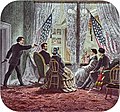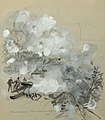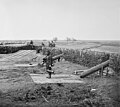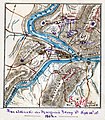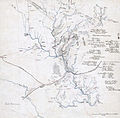Portal:American Civil War
 |
 |

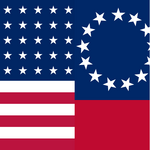
The American Civil War (1861–1865) was a sectional rebellion against the United States of America by the Confederate States, formed of eleven southern states' governments which moved to secede from the Union after the 1860 election of Abraham Lincoln as President of the United States. The Union's victory was eventually achieved by leveraging advantages in population, manufacturing and logistics and through a strategic naval blockade denying the Confederacy access to the world's markets.
In many ways, the conflict's central issues – the enslavement of African Americans, the role of constitutional federal government, and the rights of states – are still not completely resolved. Not surprisingly, the Confederate army's surrender at Appomattox on April 9,1865 did little to change many Americans' attitudes toward the potential powers of central government. The passage of the Thirteenth, Fourteenth and Fifteenth amendments to the Constitution in the years immediately following the war did not change the racial prejudice prevalent among Americans of the day; and the process of Reconstruction did not heal the deeply personal wounds inflicted by four brutal years of war and more than 970,000 casualties – 3 percent of the population, including approximately 560,000 deaths. As a result, controversies affected by the war's unresolved social, political, economic and racial tensions continue to shape contemporary American thought. The causes of the war, the reasons for the outcome, and even the name of the war itself are subjects of much discussion even today. (Full article)

The United States Zouave Cadets (also known as the Chicago Zouaves and Zouave Cadets of Chicago) was a short-lived zouave unit of the Illinois militia that has been credited as the force behind the surge in popularity of zouave infantry in the United States and Confederate States in the mid-19th century. The United States Zouave Cadets were formed by Elmer Ellsworth in 1859 from the National Guard Cadets of Chicago, established three years earlier. The unit's 1860 tour of the eastern United States popularized the distinctive zouave appearance and customs, directly and indirectly inspiring the formation of dozens of similar units on the eve of the American Civil War.
During the governorship of William Henry Bissell, the United States Zouave Cadets were granted the ceremonial designation of Governor's Guard of Illinois on 23 January 1860. Its march was the "Zouave Cadets Quickstep". (Full article...)
The history of Idaho in the American Civil War is atypical, as the territory was far from the battlefields.
At the start of the Civil War, modern-day Idaho was part of the Washington Territory. On March 3, 1863, the Idaho Territory was formed, consisting of the entirety of modern-day Idaho, Montana, and all but southwest Wyoming. However, there were concerns about Confederate sympathizers in the eastern half of the territory, in what is present-day Montana. As a result, in 1863 Sidney Edgerton traveled quickly to see President Abraham Lincoln about the situation; this was one reason to split the Montana Territory from the Idaho Territory. The split also resulted in most of Idaho Territory's land consisting of modern-day Wyoming being reassigned to the Dakota Territory. (Full article...)
James Wood Bush (c. 1844–45 – April 24, 1906) was an American Union Navy sailor of British and Native Hawaiian descent. He was among a group of more than one hundred Native Hawaiian and Hawaii-born combatants in the American Civil War, at a time when the Kingdom of Hawaii was still an independent nation.
Enlisting in the Union Navy in 1864, Bush served as a sailor aboard USS Vandalia and the captured Confederate vessel USS Beauregard, which maintained the blockade of the ports of the Confederacy. He was discharged from service in 1865 after an injury, which developed into a chronic condition in later life. The impoverished Bush was unable to return to Hawaii for more than a decade, during which time he traveled through New England and much of the Pacific. Back in Hawaii, he worked as a government tax collector and road supervisor for the island of Kauai, where he settled down. In later life, he converted to Mormonism and became an active member of the Hawaiian Mission. After the annexation of Hawaii to the United States, Bush was recognized for his military service, and in 1905 was granted a government pension for the injuries he received in the Navy. He died at his home on Kauai on April 24, 1906. (Full article...)
- ... that in the aftermath of the American Civil War, the only Black-led organization providing teachers to formerly enslaved people was the African Civilization Society?
- ... that some Confederate bullets were sourced from a silver mine?
- ... that The Land We Love, a little magazine that merged into Southern Magazine, printed American Civil War recollections, poetry, agricultural material, and many works by female authors?
- ... that Emma Dean Powell received a pass from General Ulysses S. Grant to accompany her husband to battlefield camps during the American Civil War after he lost his arm?
- ... that Francis Orray Ticknor was a country doctor whose fame as a poet relies on "Little Giffen", a poem about one of his patients who died in the American Civil War?
- ... that some historians believe that Steele's Greenville expedition marked a shift in the Union's war policy?
- Attention needed
- ...to referencing and citation • ...to coverage and accuracy • ...to structure • ...to grammar • ...to supporting materials
- Popular pages
- Full list
- Cleanup needed
- The West Tennessee Raids
- Requested articles
- James Ashby (soldier) • Bluffton expedition • Benjamin D. Fearing • Charles A. Hickman • Richard Henry Jackson • James B. Speers • Charles S. Steedman • Battle of Barton's Station • Lawrence P. Graham • Thomas John Lucas • Daniel Henry Rucker • James Hughes Stokes • Frederick S. Sturmbaugh • Davis Tillson • Action at Nineveh (currently a redirect) • International response to the American Civil War • Spain and the American Civil War • Savannah Campaign Confederate order of battle • Native Americans in the American Civil War (currently disambiguation after deletion) • 1st Battalion, Mississippi Mounted Rifles (Union) • Battle of Lafayette • Requested American Civil War Medal of Honor recipients
- Expansion needed
- Battle of Boonsborough • Battle of Guard Hill • Battle of Rice's Station • Battle of Simmon's Bluff • Battle of Summit Point • Charleston Arsenal • Edenton Bell Battery • First Battle of Dalton • Blackshear Prison • Edwin Forbes • Hiram B. Granbury • Henry Thomas Harrison • Louis Hébert (colonel) • Benjamin G. Humphreys • Maynard Carbine • Hezekiah G. Spruill • Smith carbine • Edward C. Walthall • Confederate States Secretary of the Navy • Confederate States Secretary of the Treasury • David Henry Williams • Battle of Rome Cross Roads • Delaware in the American Civil War • Ironclad Board • United States Military Railroad • Kansas in the American Civil War • Rufus Daggett • Ebenezer Magoffin • Confederate Quartermaster-General's Department • First Corps, Army of Northern Virginia • Francis Laurens Vinton • Henry Maury • Smith's Expedition to Tupelo • Other American Civil War battle stubs • Other American Civil War stubs
- Images needed
- Battle of Lone Jack • Preston Pond, Jr. • Melancthon Smith
- Merging needed
- 1st Regiment New York Mounted Rifles and 7th Regiment New York Volunteer Cavalry
- Citations needed
- 1st Alabama Cavalry Regiment (Union) • 4th Maine Battery • 33rd Ohio Infantry • 110th New York Volunteer Infantry • Battle of Hatcher's Run • Camp Dennison • Confederate colonies • CSS Resolute • Dakota War of 1862 • Florida in the American Civil War • Ethan A. Hitchcock (general) • Fort Harker (Alabama) • Gettysburg (1993 film) • Iowa in the American Civil War • Second Battle of Fort Sumter • Samuel Benton
- Translation needed
- Add an article here!
The following Wikimedia Foundation sister projects provide more on this subject:
-
Commons
Free media repository -
Wikibooks
Free textbooks and manuals -
Wikidata
Free knowledge base -
Wikinews
Free-content news -
Wikiquote
Collection of quotations -
Wikisource
Free-content library -
Wikiversity
Free learning tools -
Wikivoyage
Free travel guide -
Wiktionary
Dictionary and thesaurus
- Shortcuts to this page: Portal:ACW • P:ACW




















